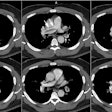Radiology 2002 Feb;222(2):483-90
Subsegmental pulmonary emboli: improved detection with thin-collimation
multi-detector row spiral CT.
Schoepf UJ, Holzknecht N, Helmberger TK, Crispin A, Hong C, Becker CR, Reiser
MF.
PURPOSE: To compare different reconstruction thicknesses of thin-collimation
multi-detector row spiral computed tomographic (CT) data sets of the chest for
the detection of subsegmental pulmonary emboli. MATERIALS AND METHODS: A
multi-detector row spiral CT protocol for the diagnosis of pulmonary embolism
was used that consisted of scanning the entire chest with 1-mm collimation
within one breath hold. In 17 patients with central pulmonary embolism, the raw
data were used to perform reconstructions with 1-mm, 2-mm, and 3-mm section
thicknesses. For each set of images, each subsegmental artery was independently
graded by three radiologists as open, containing emboli, or indeterminate.
RESULTS: For the rate of detection of emboli in subsegmental pulmonary arteries,
use of the 1-mm section width yielded an average increase of 40% when compared
with the use of 3-mm-thick sections (P <.001) and of 14% when compared with
the use of 2-mm-thick sections (P =.001). With the use of 1-mm sections versus
3-mm sections, the number of indeterminate cases decreased by 70% (P =.001).
Interrater agreement was substantially better with the use of 1-mm and 2-mm
sections than with the use of 3-mm sections. CONCLUSION: For the diagnosis of
subsegmental pulmonary emboli at multi-detector row CT, the use of 1-mm section
widths results in substantially higher detection rates and greater agreement
between different readers than the use of thicker sections.







